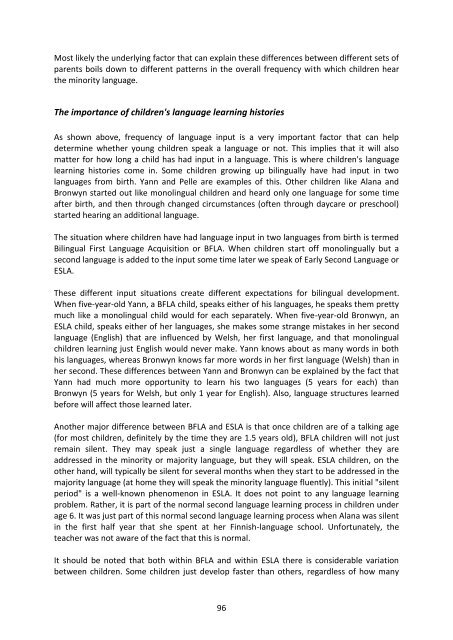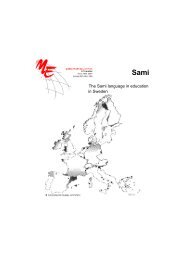Multilingual Early Language Transmission (MELT) - Mercator ...
Multilingual Early Language Transmission (MELT) - Mercator ...
Multilingual Early Language Transmission (MELT) - Mercator ...
You also want an ePaper? Increase the reach of your titles
YUMPU automatically turns print PDFs into web optimized ePapers that Google loves.
Most likely the underlying factor that can explain these differences between different sets of<br />
parents boils down to different patterns in the overall frequency with which children hear<br />
the minority language.<br />
The importance of children's language learning histories<br />
As shown above, frequency of language input is a very important factor that can help<br />
determine whether young children speak a language or not. This implies that it will also<br />
matter for how long a child has had input in a language. This is where children's language<br />
learning histories come in. Some children growing up bilingually have had input in two<br />
languages from birth. Yann and Pelle are examples of this. Other children like Alana and<br />
Bronwyn started out like monolingual children and heard only one language for some time<br />
after birth, and then through changed circumstances (often through daycare or preschool)<br />
started hearing an additional language.<br />
The situation where children have had language input in two languages from birth is termed<br />
Bilingual First <strong>Language</strong> Acquisition or BFLA. When children start off monolingually but a<br />
second language is added to the input some time later we speak of <strong>Early</strong> Second <strong>Language</strong> or<br />
ESLA.<br />
These different input situations create different expectations for bilingual development.<br />
When five-year-old Yann, a BFLA child, speaks either of his languages, he speaks them pretty<br />
much like a monolingual child would for each separately. When five-year-old Bronwyn, an<br />
ESLA child, speaks either of her languages, she makes some strange mistakes in her second<br />
language (English) that are influenced by Welsh, her first language, and that monolingual<br />
children learning just English would never make. Yann knows about as many words in both<br />
his languages, whereas Bronwyn knows far more words in her first language (Welsh) than in<br />
her second. These differences between Yann and Bronwyn can be explained by the fact that<br />
Yann had much more opportunity to learn his two languages (5 years for each) than<br />
Bronwyn (5 years for Welsh, but only 1 year for English). Also, language structures learned<br />
before will affect those learned later.<br />
Another major difference between BFLA and ESLA is that once children are of a talking age<br />
(for most children, definitely by the time they are 1.5 years old), BFLA children will not just<br />
remain silent. They may speak just a single language regardless of whether they are<br />
addressed in the minority or majority language, but they will speak. ESLA children, on the<br />
other hand, will typically be silent for several months when they start to be addressed in the<br />
majority language (at home they will speak the minority language fluently). This initial "silent<br />
period" is a well-known phenomenon in ESLA. It does not point to any language learning<br />
problem. Rather, it is part of the normal second language learning process in children under<br />
age 6. It was just part of this normal second language learning process when Alana was silent<br />
in the first half year that she spent at her Finnish-language school. Unfortunately, the<br />
teacher was not aware of the fact that this is normal.<br />
It should be noted that both within BFLA and within ESLA there is considerable variation<br />
between children. Some children just develop faster than others, regardless of how many<br />
96



